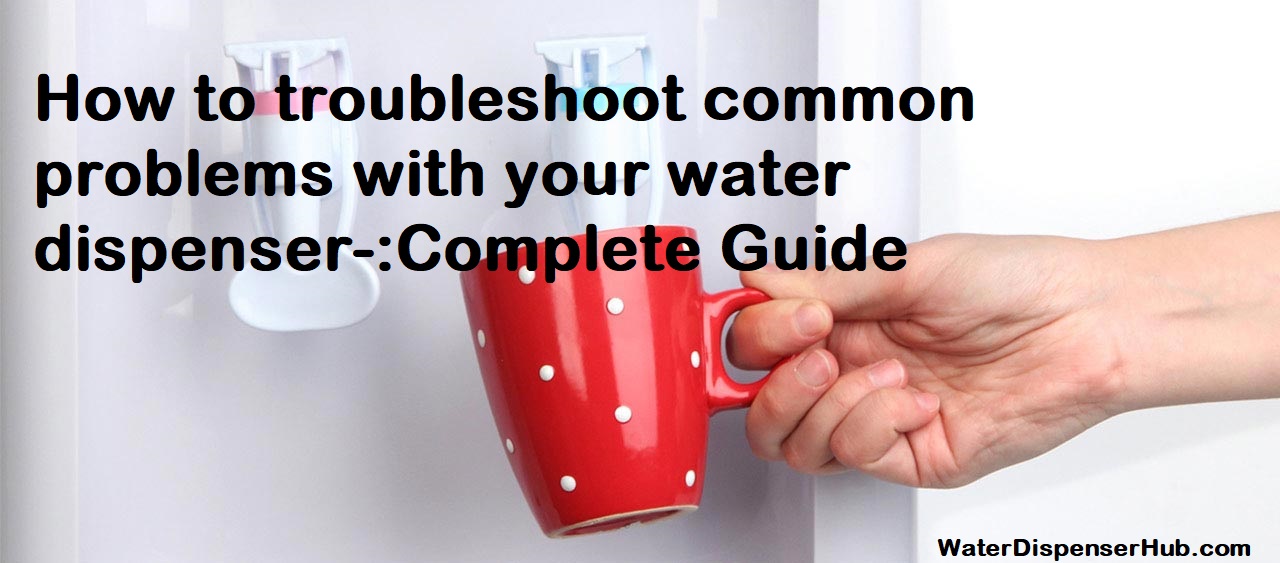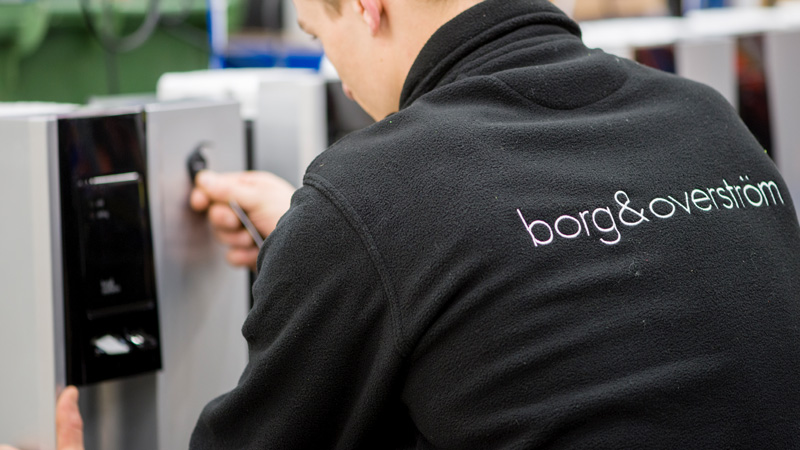Are you having trouble getting your water dispenser to work? You’re not alone! Many people face similar problems.
From slow water flow to clogged filters, this complete guide will help you troubleshoot and fix common issues with your water dispenser. Let’s get started!
Welcome to this comprehensive guide on how to troubleshoot common problems with your water dispenser. This guide will help you identify the most common issues and provide helpful tips to get your dispenser running again.
We’ll begin with a basic overview of the different components of a water dispenser and how they work together. Then, we’ll look at some of the most common causes for problems including hardware failures, blocked filters and supply line degradation. Finally, we’ll describe some simple trouble-shooting methods for identifying the root cause of a problem before attempting more advanced repairs.
By following this guide, you should be able to return your water cooler or dispenser to proper operation in no time!

Importance of water dispensers
Water dispensers are an important component of any home that don’t receive their water directly from a tap. Water dispensers can provide both hot and cold water instantly, making them a more efficient alternative to using a kettle to boil water, especially if you’re looking for multiple cups of hot drinks in quick succession.
Some families may have large jugs of filtered water delivered, while some will buy 5-gallon bottles at supermarkets or in bulk. In either case, a water dispenser is an essential component of the process since it allows the user to access clean, purified drinking and cooking water at the press of a button.
Not only is it more convenient than boiling multiple kettles full of unfiltered tap water but most modern dispensers will include filtration and purifying systems which act as an extra layer of security in ensuring that you’re not consuming potentially harmful chemicals or pollutants from your drinking source. Water vapor produced from countertop units also has many health benefits including providing moisture to your skin, helping with sinus problems and even reducing snoring!
Common problems with water dispensers
Water dispensers are a convenient way to have instant access to chilled water. However, like any system, they sometimes need maintenance or repairs. It is important to know how to identify and address some of the most common problems associated with water dispensers so that you can quickly and efficiently fix them. The following information will guide you through the most common issues and their solutions.
1) Unit is not cold – If your water dispenser is not getting cold when in refrigerator mode, the most likely cause is an issue with the thermistor or evaporator fan motor. Check both the thermistor and fan motor as they can be easily replaced if they are damaged or malfunctioning.
2) Water leaking from unit – Often times this issue stems from a failed o-ring seal or a blocked drain tube. Replacing the o-ring should resolve the issue quickly and easily if it is no longer functioning correctly. If not, check that nothing is blocking your drain tube as this could lead to an overfill condition which results in leakage from your unit.
3) Unit takes too long to chill water – If this happens, first ensure that you have selected the correct refrigerator setting on your water dispenser as this should get it up and running again relatively quickly (if this doesn’t work then refer to problem one above). If your unit still has difficulty cooling down after verifying that you have selected the proper setting, then there might be a fault with one of its components such as its evaporator or condenser fans which need replacing for it to operate correctly again
4) Incorrect temperature – This can be caused by incorrect settings on the thermostat of your unit so make sure these are set correctly and adjust them awhile needed if they’re not working properly In addition, air flow issues within some units cause them not to maintain their temperature accurately so make sure your unit has proper airflow within its system before calling for professional help
Basic troubleshooting steps
If you’re having difficulty with your water dispenser, consider the following basic troubleshooting steps:
- Check the power source. Make sure that the appliance’s power cord is plugged into a functional outlet, and check to see if a fuse is necessary. If there is no electricity supply to the outlet, reset it from your circuit breakers.
- Check to make sure that all of the filter cartridges are installed in their proper positions and working properly. Also, make sure there are no clogs or blockages between your water supply and the tank on your dispenser unit.
- Examine any valves or connection lines for proper functioning and ensure that they aren’t blocked with debris or corrosion. If these pipes are found to be leaking, replace them immediately if possible or contact an authorized service provider if replacements are not available to you.
- Look over any internal mechanisms such as pumps and motors for signs of malfunctioning. If there appears to be a problem with either one of these parts, contact an authorized service provider for assistance in replacing them as soon as possible before further damage occurs due to their lack of proper functioning.
- Monitor your water temperatures using thermometers placed at various points along your pipes and pumps for indications of overheating or cooling beyond operational ranges which can lead to malfunctioning and excess energy use by the unit over time. If results show that this isn’t happening then check for air flow restrictions due to extreme blockages or narrowing in vents or piping systems.
Check the power source
- Check the power source: Before you attempt any other troubleshooting techniques, it is important to ensure the water dispenser is properly supplied with power. Start by checking that the plug is firmly attached to a working wall outlet and that the cord as well as all its attached components are in good condition with no exposed wires or signs of damage. If everything appears to be connected correctly, it is possible there may be an issue with the house’s fuse box. To test this, plug another working device into the outlet and if it functions normally, then the fault lies within your water dispenser and you can move onto step B.
Inspect the water supply line
- Once you determine that your water supply is functioning properly, the next step is to check the supply line carefully. Make sure no kinks or damage to prevent your water dispenser from proper operation are present. Inspecting the supply line also helps you identify if certain problems such as a poor connection may be causing issues with your water dispenser. A tight connection ensures that no air can enter the system and impede flow.
If you notice any abnormalities such as cracks or leaks in any point of the line, it is best to inspect further and consider replacements if necessary. Further inspection should include ensuring that all regulator valves, pressure relief valves and blow-off valves are in proper working order and allowing the right amount of pressure in the system for optimal performance.
If necessary, replace all components in question for ideal functioning of your water dispensers.
Clean the dispenser’s exterior
Before beginning, unplug the water dispenser and turn off the water feed valve.
To ensure that any dirt or grime that has built up on the exterior of your water dispenser is properly removed, use a soft cloth and warm soapy water. Make sure to check the drip tray to see if it needs to be emptied and washed as well. Avoid using harsh chemicals or abrasive materials as this may cause damage to the finish of your dispenser.
Once you have cleaned the exterior of your appliance, dry it with a clean cloth.
III. Specific troubleshooting steps
If the water dispenser is not cooling or producing hot water, review the following steps to help you troubleshoot the problem.
- Check to make sure that both the unit and household circuit breakers are in the “on” position and that all connections are properly engaged.
- If you have a four-prong electrical cord, unplug it and plug it into a three-prong outlet to check if it’s operating properly without any additional power cords. Make sure to use an UL Listed power cord that is rated for 15 amps and 120 volts, AC only.
- Verify whether the tank is connected to a reverse osmosis filter system or whether it was recently added onto existing plumbing lines in your house: either way, check for any low pressure problems with your home’s water lines or filter system by turning off the water supply valve underneath the sink then turn on all faucets connected to your home’s plumbing until they produce air or no more water comes out of them. Turn back on the valve then check if there’s enough pressure regulation coming from a regulator tap mounted onto your water line leading up to your water dispenser’s tank as well as sufficient pressure from incoming municipal (public) pipes if applicable, so that your device gets adequate flow of cold/hot drinking waters flowing into its reservoir tank at steady rates and within predetermined temperature ranges which vary depending upon machine’s models (it should be noted here that failure of proper temperature control may be caused by other possible problems such as faulty thermostats located on these devices; please refer later down this section for details).
- Verify that connections from hoses and valves are correctly engaged, both from upper side –coming from cold/hot drinking tanks– as well as lower-side connections going down –from machine’s syphoning tubing– toward a dedicated drainpipe at lower level space near where unit sits in order avoid any possible leakage due improper fitting of those components whenever disposed inappropriately during installation process Upon finishing this step, make sure their placement correctly lies within reachable distances between dependable wire fittings while conforming shapely template designs pointed out over herein an abbreviated illustration reference chart; please refer back towards previous sections accordingly!
Water not dispensing
A water dispenser that won’t dispense water is a common problem. Before troubleshooting, you should make sure that the power to the unit is on and that the outlet it is plugged into works. If both of these conditions are met, then it is time to take a closer look at your water dispenser.
Common issues which could prevent your water dispenser from working include: foreign objects lodged in the spout or valve, clogged filters, problems with the compressor or pressure tank, and air bubbles blocking the flow of water. You may also have an issue with your internal or external pipes if your home does not have basic plumbing facilities.
If an object has been stuck in the spout or valve, try to remove it using a pair of long-handled pliers and cleaning solutions if necessary. If this doesn’t work, you may need to call a professional plumber for assistance. Clogged filters can be easily checked and replaced if necessary. Compressor and pressure tank issues should only be handled by qualified technicians who are knowledgeable about appliances like water coolers and dispensers. Finally, air bubbles can also cause disruption in flow – bleed any airlocks by pushing down on the tap for about 15 seconds until you hear a gurgling sound as any trapped air escapes into the system.
Low water flow rate
If the water flow rate is low at first but gradually increases in time, it is a sign that the filter inside your water cooler may be clogged. Unplugging and cleaning the filter should help resolve this issue. If you find that your filter needs to be replaced, refer to your user guide for instructions on how to do so.
If, however, this does not resolve the issue, it could mean that there is a build-up of sediment or dirt within the water line. To clean any debris out of your water line, turn off the power to your water dispenser and disconnect it from its water source. Connect an air compressor hose to an air compressor tank and then run a hose from its test connection plug into the inlet side of the valve on top of your dispenser after setting its regulator valve up at 15 psi or less. Pump compressed air into this line until all bubbles have ceased coming out of both drains simultaneously and wallah! Your problem should be resolved!
For detailed instructions on troubleshooting this issue please refer to your user guide or service manual provided with purchase.
Water not chilled
If your water is not reaching the desired temperature, first examine the condenser coils (located at the back of the unit) to make sure they are clean and free of debris. Also, check whether the thermostat settings and freezer temperatures are correct as they may need to be adjusted.
If direct cooling is enabled, verify that the cold water line is properly connected from the apparatus to a source that can provide chilled water. Finally, check all connections between components for a secure fit.
If all troubleshooting steps have been followed and you are still not able to resolve this issue, please contact your manufacturer for additional assistance.
Conclusion
In conclusion, troubleshooting common issues with your water dispenser is extremely important to ensure you can continue to enjoy clean and safe drinking water. If a problem persists, seeking professional help may be the best option as faulty wiring and valves can cause serious safety risks.
Keep your water filter regularly serviced or replaced, and refer to these tips to diagnose any issues that come up!
FAQ’s
How do you troubleshoot a water dispenser?
- Check if the power cord is properly plugged in.
- Ensure that the water bottle is properly installed.
- Verify if the dispenser is receiving water.
- Look for any blockages or leaks in the dispenser.
- Check the dispenser’s thermostat or temperature control settings.
Why is my water dispenser not dispensing any water?
- The dispenser might not be receiving any water.
- The dispenser’s water line might be clogged.
- The dispenser’s filter might need replacement.
- The dispenser’s solenoid valve might be faulty.
- The dispenser’s switch or button might be broken.
What maintenance does a water dispenser need?
- Regular cleaning of the dispenser’s exterior and interior.
- Replacement of the dispenser’s filter as needed.
- Cleaning of the dispenser’s drip tray and water reservoir.
- Sanitizing the dispenser’s dispensing nozzle.
- Checking for any leaks or blockages in the dispenser.
How do you fix a water dispenser that is not cooling?
- Check the dispenser’s thermostat or temperature control settings.
- Clean the dispenser’s condenser coils.
- Verify if the dispenser’s compressor is running.
- Inspect the dispenser’s evaporator fan motor for any damage or obstruction.
- Replace the dispenser’s temperature sensor if necessary.
What is the principle and working of water dispenser?
A water dispenser uses a compressor to cool the water, which is stored in a reservoir. The dispenser has a dispensing nozzle that is controlled by a switch or button. When the switch is pressed, water is dispensed through the nozzle.
How do you fix a slow water dispenser?
- Check if the dispenser’s filter needs replacement.
- Verify if the dispenser’s water line is clogged.
- Inspect the dispenser’s solenoid valve for any damage.
- Check the dispenser’s water pressure and adjust as needed.
- Replace the dispenser’s pump if necessary.
Can a water dispenser be repaired?
Yes, a water dispenser can be repaired, depending on the type and extent of the damage. However, it is usually more cost-effective to replace the dispenser if the repair cost is too high.
What are the sensors on a water dispenser?
The sensors on a water dispenser can include a thermostat to monitor the temperature, a pressure sensor to detect the water pressure, and a level sensor to detect the water level in the reservoir.
How do you calibrate a water dispenser?
To calibrate a water dispenser, you need to adjust the dispenser’s thermostat or temperature control settings to achieve the desired water temperature. This can usually be done using the dispenser’s control panel or settings menu.
What is the lifespan of a water dispenser?
The lifespan of a water dispenser depends on its usage, maintenance, and quality. Generally, a well-maintained water dispenser can last for 5 to 10 years.
See more-
- Best water dispenser with ice maker 2023
- Best self cleaning water dispenser 2023
- Best cold and hot water dispenser 2023
- Best countertop water dispenser 2023
- Best bottom loading water dispenser 2023

Robert Carlson is the CEO of waterdispenserhub.com and informative website, and a respected author in the dispenser industry. With years of experience and a passion for his work, Robert has become a trusted source of information for consumers and businesses alike. His dedication to excellence and commitment to providing unbiased and independent reviews have earned him a loyal following of readers who trust his expertise and insights. Robert is a true industry expert and a leader in the dispenser industry, and his work has been recognized by his peers and featured in various publications and media outlets.


